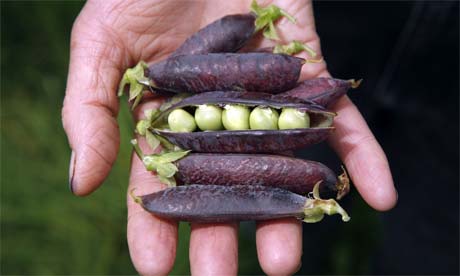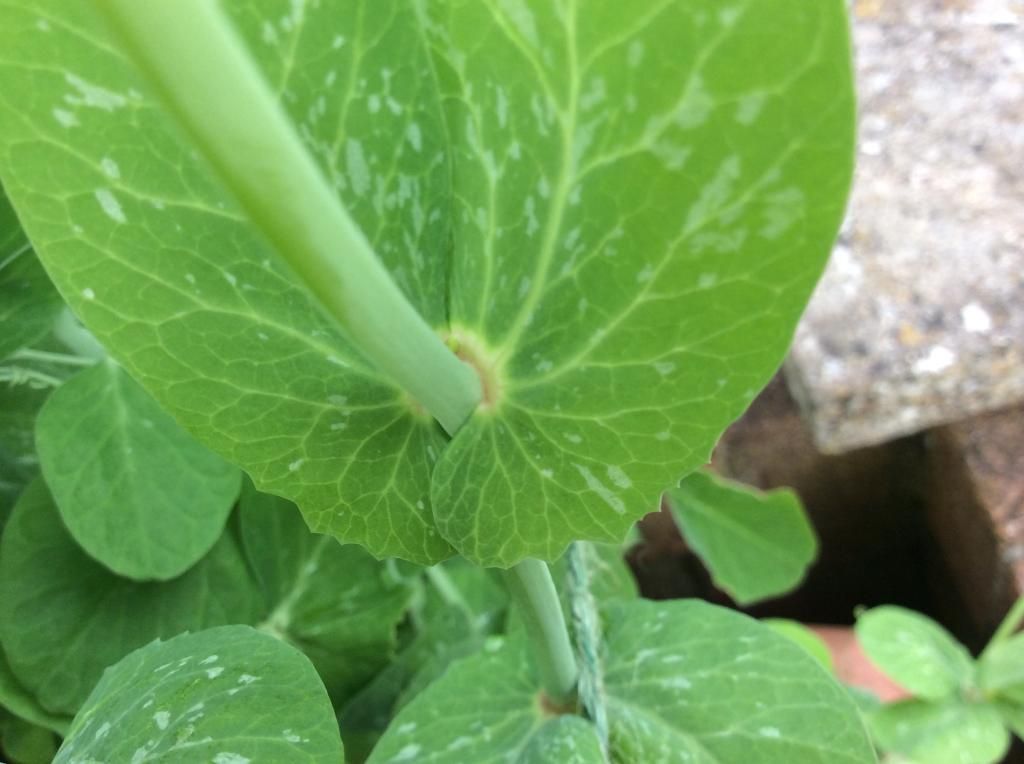I don't know the exact details of the genetics of all my pea plants. Many of the experimental varieties have their own pages on the website of the organisation that I got them from, which lists the genes the researchers know they have, but many others do not. I'm attempting to fill in the gaps by observing all the plants myself.
With this aim in mind, I went out with a notepad and assessed my plants with respect to the D gene. This controls whether pigment is deposited in the axils.
This is Purple Podded. And here's a little plant anatomy - the two leaf structures attached directly to the stem are called stipules, and that dark pink bit is the axil.
To be fair, the axil colour isn't really relevant or at all since I'm mostly interested in pod and flower colour, but it's going to illustrate an important genetic concept.
Purple Podded there has a single axil ring, caused by an allele of D called Dco. Pretty, isn't it?
And Golden Sweet has a double ring due to its Dw allele, which I think is even more attractive.
Sometimes you can get information about other genes from the axil pigmentation, for example in Salmon Flowered, which has only a little pigment. I suspect this is the result of something like the b allele modifying the anthocyanins from a deep red-purple to a paler pink, but I don't know yet whether Salmon Flowered carries b or something else entirely.
Finally these baby Telephone plants don't have any axil pigmentation at all, because of the d allele (no axil pigmentation), right? Right?
Well, not necessarily.
There's another gene that could be at work here - a. The dominant allele, A, makes the plant produce anthocyanins. The recessive a means the plant can't produce any anthocyanins at all, ever, no matter what other genes it has for where to put them.
Imagine it like a factory line building the plant. Department A is responsible for turning on the anthocyanin-making machine, and Department D is responsible for delivering that pigment it to the axil specifically. Other departments deal with delivering it to the flowers, and some to the pods (i.e. the Pu and Pur alleles I talked about in the last post). The B Department along with some others control the exact recipe that makes the pigment, changing its colour. Some will distribute pigment in a specific pattern.
None of these other alleles can do their job if the anthocyanin machine isn't switched on in the first place, because there's no anthocyanin to work with at all.
The effects of these genes are essentially hidden by a, and this is called epistasis - a is epistatic to all those other genes that do something with anthocyanin.
So my Telephone pea might have no axil pigment because of d, or no anthocyanin at all because of a. I can't tell by looking at them right now, but I know it has white flowers and green pods so a is likely.
The easiest way to tell would be to make a cross with a pea I absolutely definitely know is aa but also has anthocyanin-depositing alleles like Pu and Pur (purple pods) and Dco or Dw (axil colour) and the ones that allow flower colour. If Telephone has aa the offspring will all also be anthocyanin-less. If it has A but all the other genes are the recessive non-delivering types, we'll see pigment in the offspring. I don't have the necessary breeding material to do this but to be fair, right now it doesn't matter much to me anyway.
And it might all become clear as a result of other crosses I'm planning to make.
One woman. One garden. One scalpel. Half a degree in genetics. Hundreds of peas. Let's see what happens!
Labels
a
(1)
Absolute Zero
(1)
anatomy
(1)
axil pigment
(1)
b
(2)
d
(1)
dp
(1)
epistasis
(1)
experimental material
(2)
flower colour
(1)
food
(1)
genetics
(4)
gp
(3)
idea
(2)
me
(1)
n
(1)
p
(1)
peas
(7)
pink flowers
(1)
plan
(3)
pu
(1)
pur
(1)
purple pods
(1)
red pods
(2)
seed saving
(1)
snap
(1)
Sugar Ann
(1)
v
(1)
varieties
(3)
yellow pods
(2)
Thursday, 22 May 2014
Epistasis and the D gene
Location:
Chesterfield, Derbyshire, UK
Wednesday, 21 May 2014
More about red pods and crosses
Although I started late, my peas are doing well. The tall varieties are about 2ft tall (of course the short ones are shorter!) now and they all look absolutely beautiful, and it probably won't be too long before they think about flowering, and then I can start to actually make crosses.
The first one I'm going to talk about is Golden Sweet x Purple Podded. I've mentioned this before, but in order to get red pods I need yellow pods with purple/red anthocyanin pigments laid over it - Golden Sweet has the yellow, and Purple Podded of course has the purple.
The first one I'm going to talk about is Golden Sweet x Purple Podded. I've mentioned this before, but in order to get red pods I need yellow pods with purple/red anthocyanin pigments laid over it - Golden Sweet has the yellow, and Purple Podded of course has the purple.
Location:
Chesterfield, Derbyshire, UK
Friday, 2 May 2014
What I'm growing
I currently have seeds of 42 different types of peas. I don't have the room to grow everything this year, so some decisions had to be made prioritising the material I have.
Peas to eat
Golden Sweet, which I got from The Real Seed Catalogue. It's an old yellow-podded snow pea (i.e. you eat the flat young pods) and it's delicious. It's tall, and had purple flowers.
Purple Podded, which Celia kindly sent to me a few years ago. Like the name says it has purple pods, and it makes a good soup pea. I love the contrast of the purple pods and flowers against the green foliage too.
Telephone, also from The Real Seed Catalogue. Another tall pea, this one an old shelling-type with green pods. This is new to me this year, so I don't know much about it other than the description on the site.
Sugar Ann, a short snap-type pea (like a snow pea in that you eat the pods too, but the pods are thick and fleshy rather than flat). It has green pods and white flowers and is apparently very early for a snap.
Sugar Bon, which I bought because it was extremely cheap from Lidl. I assume it's similar to Sugar Ann but I haven't tried it before.
Peas for seed saving and breeding
All of the above, plus:
Salmon Flowered, from Galina at Allotments4All. An unusual variety which has fasciated stems (they are thick and ridged as if many stems have fused together and the flowers and pods are all at the top of the plant giving it an "umbrella" effect. They look very interesting and apparently taste nice too. New to me.
Elisabeth, also from Galina. She discovered a single plant of this pea mixed in with something else. It's a pink-flowered snow pea with green pods, which I also haven't grown before.
Waverex, a popular petit pois pea. Short, white flowers, and very sweet tasty peas. Should be good for adding flavour into my project if necessary.
Also some experimental material, which is carrying various genes (mostly for flower colour) that I'd like to add. Most have codes instead of proper names, so I've given them nicknames of characters from my favourite superhero board game to make them easier for me to remember.
Absolute Zero, bluish-green pods.
Bunker, bluish-green pods, darker purple flowers.
Fanatic, pink flowers, some leaf weirdness.
Haka, bluish-violet flowers.
Legacy, cerise flowers.
Ra, pale pink flowers.
Scholar, brick/rose red flowers.
Tachyon, pink flowers, extremely weird leaves.
Tempest, purple pods.
Unity, crimson flowers.
Visionary, blue flowers, dark bluish-green foliage.
Wraith, yellow pods.
That's 20 different types. I must be mad. ;)
Peas to eat
Golden Sweet, which I got from The Real Seed Catalogue. It's an old yellow-podded snow pea (i.e. you eat the flat young pods) and it's delicious. It's tall, and had purple flowers.
Purple Podded, which Celia kindly sent to me a few years ago. Like the name says it has purple pods, and it makes a good soup pea. I love the contrast of the purple pods and flowers against the green foliage too.
Telephone, also from The Real Seed Catalogue. Another tall pea, this one an old shelling-type with green pods. This is new to me this year, so I don't know much about it other than the description on the site.
Sugar Ann, a short snap-type pea (like a snow pea in that you eat the pods too, but the pods are thick and fleshy rather than flat). It has green pods and white flowers and is apparently very early for a snap.
Sugar Bon, which I bought because it was extremely cheap from Lidl. I assume it's similar to Sugar Ann but I haven't tried it before.
Peas for seed saving and breeding
All of the above, plus:
Salmon Flowered, from Galina at Allotments4All. An unusual variety which has fasciated stems (they are thick and ridged as if many stems have fused together and the flowers and pods are all at the top of the plant giving it an "umbrella" effect. They look very interesting and apparently taste nice too. New to me.
Elisabeth, also from Galina. She discovered a single plant of this pea mixed in with something else. It's a pink-flowered snow pea with green pods, which I also haven't grown before.
Waverex, a popular petit pois pea. Short, white flowers, and very sweet tasty peas. Should be good for adding flavour into my project if necessary.
Also some experimental material, which is carrying various genes (mostly for flower colour) that I'd like to add. Most have codes instead of proper names, so I've given them nicknames of characters from my favourite superhero board game to make them easier for me to remember.
Absolute Zero, bluish-green pods.
Bunker, bluish-green pods, darker purple flowers.
Fanatic, pink flowers, some leaf weirdness.
Haka, bluish-violet flowers.
Legacy, cerise flowers.
Ra, pale pink flowers.
Scholar, brick/rose red flowers.
Tachyon, pink flowers, extremely weird leaves.
Tempest, purple pods.
Unity, crimson flowers.
Visionary, blue flowers, dark bluish-green foliage.
Wraith, yellow pods.
That's 20 different types. I must be mad. ;)
Labels:
experimental material,
food,
peas,
seed saving,
varieties
Location:
Chesterfield, Derbyshire, UK
Thursday, 1 May 2014
Pod colours, and some genetics
There's a surprising amount of variety in the colours of pea pods. We all know the standard green ones, but it's possible to get the following as well:
*Purple (courtesy of the Guardian)

*Yellow (grown by me, years ago)

*Red (courtesy of the lovely Rebsie Fairholm)

*Bluish-green (no picture, sorry, but I am growing a couple of types with this colour so I can show you later in the year)
*Purple (courtesy of the Guardian)

*Yellow (grown by me, years ago)

*Red (courtesy of the lovely Rebsie Fairholm)

*Bluish-green (no picture, sorry, but I am growing a couple of types with this colour so I can show you later in the year)
Labels:
b,
genetics,
gp,
peas,
pink flowers,
plan,
pu,
pur,
purple pods,
red pods,
yellow pods
Location:
Chesterfield, Derbyshire, UK
Subscribe to:
Posts (Atom)



